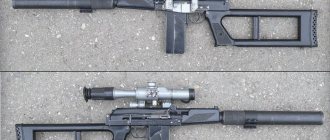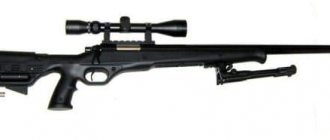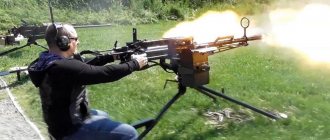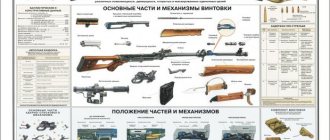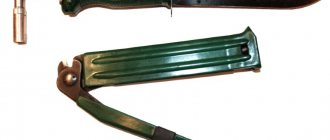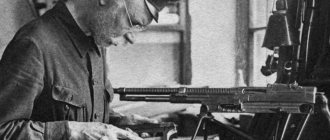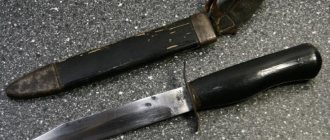Scout knives, quite well-known and widely used during the Great Patriotic War, were further developed in more modern modifications. Already in the 70s, the first shooting knife appeared, and the HP-40 is considered its ancestor. It was and is an indispensable assistant for special forces of the army and certain special services.
The progenitor of the NRS is the HP-40 knife.
What was the scout knife used for?
The development of a special knife for the scout began in accordance with the order of the Ministry of Defense. The designers tried hard, and the NRS “Scout Shooting Knife” was born.
The version of the blade turned out to be a completely ordinary combat weapon. But in reality, it has become a combined weapon for silently eliminating the enemy.
The management, seeing all the possibilities of a seemingly ordinary blade, immediately classified the development. And there were more stories about him than there were specific characteristics.
LDC equipment
Its appearance did not give away its dual purpose. There are legends that it was later demonstrated to foreigners, and none of them realized its dual purpose. The Tula masters did their best; he could perfectly neutralize the enemy in close combat, and, if necessary, at a distance.
The NRS knife is disassembled (the “barrel” with the cartridge is visible).
The knife-pistol was loaded with a silent SP-3 cartridge, specially designed for pistols with a “silent” shot. The use of a knife as a working tool was not limited in any way. It easily cut rope, slings or cords; the saw on the butt closer to the handle played a huge role in these qualities.
The knife has a device for cutting wire, it is possible to saw small steel rods, cut various wires and even live wires, use it as a screwdriver, etc. The blade turned out to have a fairly wide spectrum of action.
LDC knife design
NRS knife
There was a firing device in the handle of the knife; it was single-shot.
It contained: a removable barrel 6 cm long with a chamber, which had a firing mechanism with a safety lock and a trigger button.
To reload, you had to remove the barrel and insert a new cartridge. Then he returned to his original place and the weapon was ready to fire.
PB pistol: without unnecessary noise
The PB silent pistol is a development of TsNIITochmash in the interests of army intelligence and KGB services. Despite the external similarity and partial unification with the Makarov pistol, the PB is an independent work of gunsmiths near Moscow. A special feature of the pistol is the design of the muffler, which consists of two parts: the main one and the nozzle. If necessary, the attachment can be quickly installed on the weapon, but you can shoot without it - then the PB works like a regular pistol.
Photo: Kalashnikov Concern
The speed of the PB bullet is subsonic (290 m/s), accordingly, it does not create a shock wave. Contrary to its name, the pistol still produces a slight noise when fired, which can be heard at a distance of 50 m, which corresponds to the maximum range of use of the weapon. The pistol uses standard 9x18 mm PA cartridges. Despite the fact that the PB was developed back in 1967, it still continues to be produced at the Izhevsk Mechanical Plant and is in service with intelligence and special services. At the same time, its good balance, high level of strength and durability are noted.
Tactical and technical characteristics of knives NRS and NRS-2
Aiming with a shooting knife is quite inconvenient, but with certain skills and training, you can achieve normal results.
But in reality, according to the fighters themselves, they had to shoot from it no further than 5-6 meters. From such a distance it is quite easy for a trained person to hit the target.
There is a front sight on the handle and a rear sight in the guard. Reloading time takes a lot of time, but initially there was no task to make a knife-revolver, and if you remember muskets, a time of 1 minute can be considered normal.
Technical characteristics of the NRS knife
The bullet speed is about 140 meters per second. One shot per minute, no faster. When shooting from a knife, a silent SP-3 cartridge was used. The shot was silent and flameless; it was possible to shoot even under water. Its technical characteristics looked like this:
- total mass of LDC with cartridge: 0.62 kg;
- total length: 32.2 cm;
- length without sheath: 29 cm;
- blade length: 16 cm;
- stem length: 6 cm;
- cartridge: 7.62x35 SP3.
Shooting took place in this way: the knife must be turned with the blade towards you, the handle must be pointed at the target, it must be held with both hands, the sheath must be on. Aimed firing range is 20 meters.
Technical characteristics of the knife NRS-2
LDC In 1986, it underwent minor changes related specifically to its firearms ability. The old cartridge, the PS-3 system, was replaced with a more modern PS-4.
Knife NRS-2.
The initial speed of the bullet reached 200 meters per second. For this reason, it was necessary to make small design changes specifically in the firing part:
- total weight of NRS-2 with cartridge: 0.57 kg;
- total length: 32.2 cm;
- length without sheath: 29 cm;
- blade length: 16 cm;
- stem length: 6 cm;
- cartridge: 7.62x42 SP4.
The firing principle is no different from the LDC, the only thing is that the reload speed has doubled. The target firing range has increased to 25 meters. The firing device can be removed completely and replaced with a special insert.
Distinctive features of the NRS knife from the NRS-2
Shooting stance.
The NRS knife itself has an external resemblance to an AKM bayonet; at the end of the handle there is a plastic “front sight” and no screwdriver.
The most important difference between these knives is, of course, the cartridges. SP4 is significantly better in firepower than SP3.
The reconstruction was successful, the front sight was made metal and there is even the ability to adjust its height.
Complete "Set" for special forces
At the same Tula Arms Plant, several years after the release of the NRS-2, a completely new model was developed. The OTs-54 shooting knife had improved characteristics. In particular, the barrel began to point towards the blade. Thus, the fighter could easily both stab and shoot without turning the knife over. Another interesting feature of the special forces knife “Komplekt” was the ability to replace barrels with existing cartridges.
OTs-54 “Komplekt”
In the arsenals of reconnaissance groups, as a rule, there are cartridges of various calibers. The inventors of the “Komplekt” shooting knife equipped it with a replaceable barrel. It turned out that the special forces could use 9 mm, 7.62 and 5.45 caliber cartridges by simply replacing the knife handle. In addition, the OTs-54 was small in size and could easily be hidden in clothing. It was most often used by GRU soldiers during missions in Syrian cities in the eighties and nineties. But soon its place in the arsenal of special forces soldiers was taken by a new development.
The order of firing a shot from the NRS/NRS-2
It is clear that the shooting device is narrow-profile. And they are unlikely to use it for every task. The saying: “Rarely - but accurately” is more suitable here. But there are times when this single shot can become fatal and the advantage in the current situation will be on your side. The order of firing from the NRS-2 knife:
- Using a turning motion, it is necessary to remove the “locking device”.
- Having installed the cartridge in the chamber, without turning it over, it should be inserted into the appropriate slots in the firing device box.
- Then you need to turn the barrel in this position until there is a characteristic “click” and the mechanism falls into place.
- The trigger lever must be lifted up and released. Please note that the safety must be in the firing position.
- Feel the trigger lever under your right index finger. Take the knife with the blade towards you and press it between your palms from below. No finger should be on top of the muzzle.
- Once you take aim, you can fire a shot. After shooting, you need to remove the barrel from the handle and remove the spent cartridge case.
With some skill and dexterity, all these actions should take about 30 seconds. Given the rate of fire, such a firearm can be called a one-shot weapon. But it will undoubtedly be very important.
We insert the cartridge into the barrel. Open knife. Inserting the barrel into the knife. Locking the device. Open the fuse. The safety is cocked. Preparing for shooting. Shot.
Characteristics of special SP4 cartridges
The cartridge itself is a closed type, the wafer sleeve completely hides the bullet. The noiselessness of the PS-4 cartridge is achieved due to the piston. Initially, this SP4 cartridge was developed for the Vul silent pistols. But they were able to find a use for it in combination with the LDC.
The specificity of the cartridge mechanism is that the bullet is pushed by a piston, and, having reached a narrowing, it stops. By sealing the cartridge case, gases remain in it after the shot. Thanks to this, the shot becomes silent and there is no light flash.
Previous
KnivesBody armor for a concealed carry knife
Next
KnivesTypes of knife sharpening: 3 main types
TP-82: “cosmonaut pistol”
This unique weapon owes its appearance to cosmonaut Alexei Leonov. In 1965, he and his colleague Pavel Belyaev landed in the Perm region and survived for two days in the wild taiga. To make it easier for cosmonauts and other space explorers to endure such emergency situations, TsNIITochmash, together with Tula gunsmiths, developed the TP-82 multifunctional pistol.
Pistol TP-82. Photo: JSC "TSNIITOCHMASH"
The pistol is equipped with two horizontal smooth barrels of 32 hunting caliber and one rifled barrel of 5.45 mm caliber. TP-82 was tested in the most diverse conditions; it could be used for protection against animals, as well as for hunting and signaling. The weapon was equipped with a removable butt, into which a machete knife was built. With its help it was possible to harvest firewood, lay paths, build temporary shelters and solve other problems.
The pistol was put into service in 1986 and included in the portable emergency reserve (NAZ). Two years later, the first flight of TP-82 into space took place. In total, about 100 copies were produced, and until 2006, all domestic cosmonauts were trained in working with a pistol and took it with them on flights. The TP-82 was also equipped for long-range aviation pilots, whose flights often fly over sparsely populated areas.
APS-5 assault rifle: underwater needle gun
By the early 1970s, TsNIITochmash had completed work on a special cartridge for underwater use. The bullets for it were made needle-shaped - it is this shape that allows them to overcome the resistance of water. In 1971, designers introduced the SPP-1 four-barreled pistol. A little later, in 1975, the APS underwater assault rifle was also adopted. Until 1993, the machine gun that combat swimmers were armed with remained secret.
Underwater, a needle-shaped bullet of a 5.66 mm machine gun hits a target at a distance of 30 m at a diving depth of 5 m. However, the firing range decreases with depth: 20 m at a depth of 20 m and only 10 m at a 40-meter depth. If necessary, the APS can be used on land, but in this case you can only rely on self-defense - in the air the machine gun only hits 100 m and quickly consumes its resource. It is worth noting that in the 20th century, such weapons were mass-produced only in the USSR.
